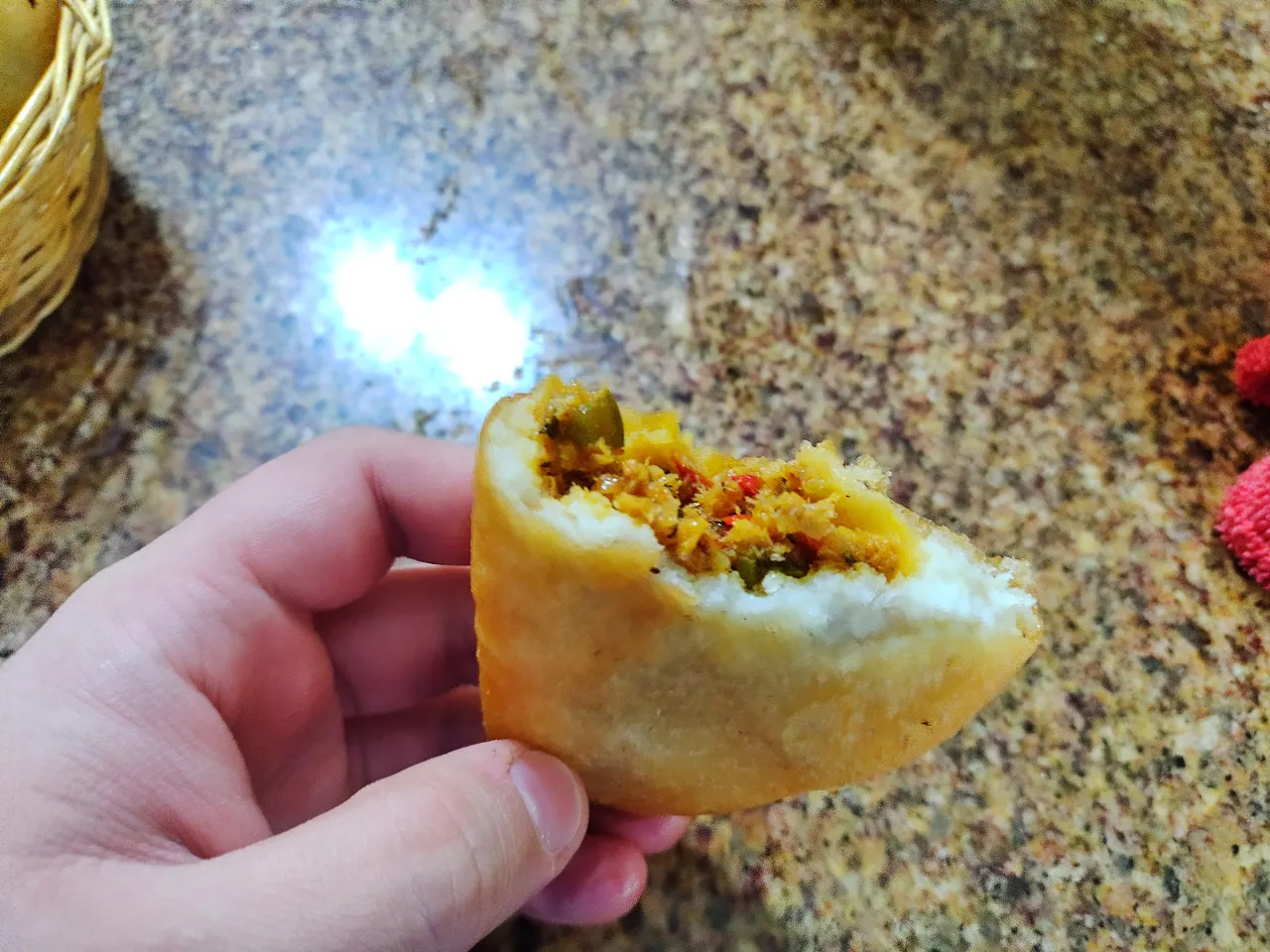Hola a todos, cómo se encuentran? Viendo algunas de las ultimas publicaciones en la comunidad de Foodies Bee Hive me enteré de un nuevo concurso por parte de @ocd, en el cual tenemos que hablar o cocinar acerca de nuestra comida típica favorita, por esta razón hoy les traigo esta receta de unas deliciosas Empanadas de Pisillo.
Hello everyone, how are you? Seeing some of the latest publications in the Foodies Bee Hive community I found out about a new contest by @ocd, in which we have to talk or cook about our favorite typical food, for this reason today I bring you this recipe for some delicious Empanadas de Pisillo.
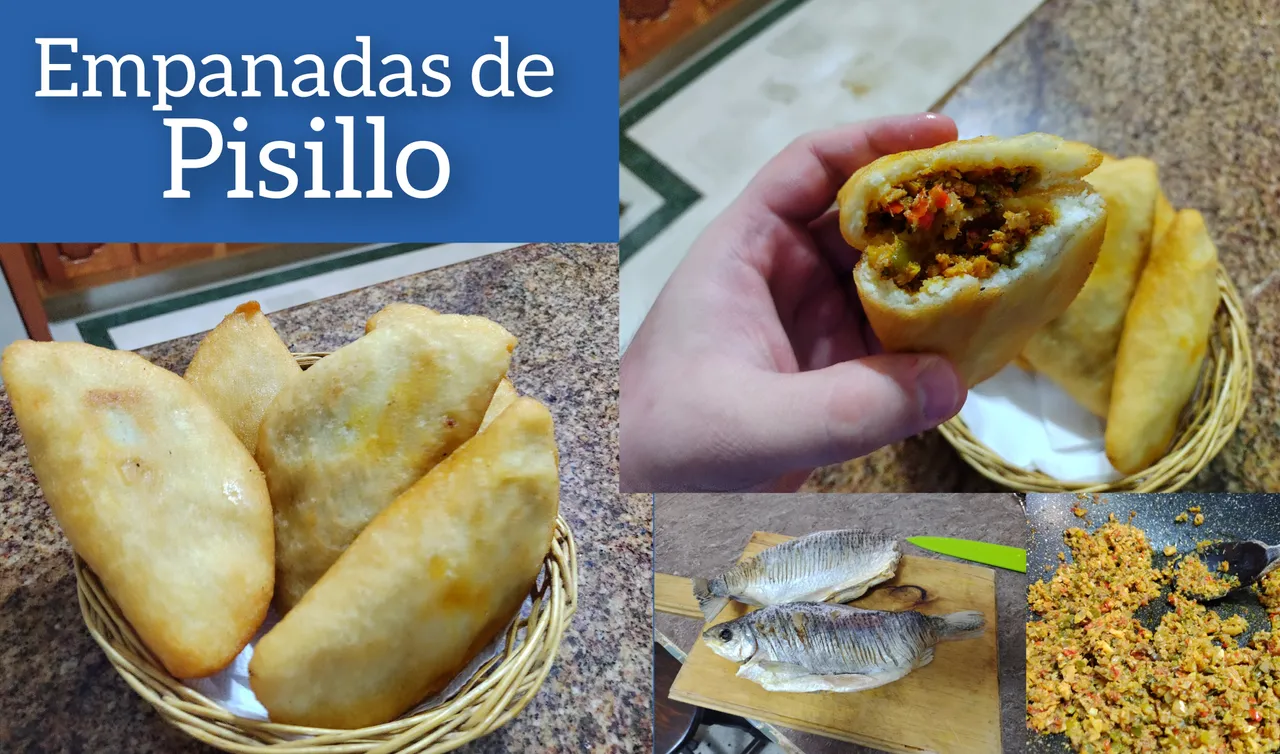
Este tipo de platos son mas comunes de la zona costera de nuestro país, y a pesar de ser de los Andes, al estudiar gran parte de mi carrera en una ciudad a pocos minutos del mar, me volví adicto a este tipo de empanadas. Otra cosa por la que decidí hacer esta receta es que tiene sus truquitos para que quede deliciosa, por lo que les enseñare algunos de ellos!
These types of dishes are more common in the coastal area of our country, and despite being from the Andes, studying much of my career in a city a few minutes from the sea, I became addicted to this type of empanadas. Another thing that I decided to make this recipe is that it has its little tricks to make it delicious, so I will show you some of them!
Ingredientes / Ingredients:
- 500 gr de Pescado, el que prefieras / 500 gr of Fish, whichever you prefer
- 400 gr de Harina de Maiz Precocido (Harina PAN) / 400 gr of Precooked Corn Flour
- 1 Tomate / 1 Tomato
- 2 Cebollas / 2 Onions
- 2 Ramas de Cilantro / 2 Branches of Coriander
- 1 Pimentón Verde / 1 Green Paprika
- 5 Ajíes Dulces / 5 Sweet Peppers
- 10 Dientes de Ajo / 10 Garlic Cloves
- Aceite Onotado / Onotated Oil
- Aceite Vegetal, suficiente para freír / Vegetable Oil, enough for frying
- Mantequilla / Butter
- Sal y Pimienta, al gusto / Salt and Pepper, to taste
Preparación / Preparation:
1- Comenzamos preparando el relleno de las empanadas / We start preparing the filling for the empanadas.
Lo primero que tienes que hacer es escoger el pescado, ya que es mucho mas sencillo trabajar con filetes ya listos que con pescados completos, por cuestiones de las espinas. Realmente el tipo de pescado no importa mucho, con cualquiera que tengas en casa quedara muy delicioso.
The first thing you have to do is choose the fish, since it is much easier to work with ready-made fillets than with complete fish, for reasons of the bones. The type of fish does not really matter much, with whatever you have at home it will be very delicious.
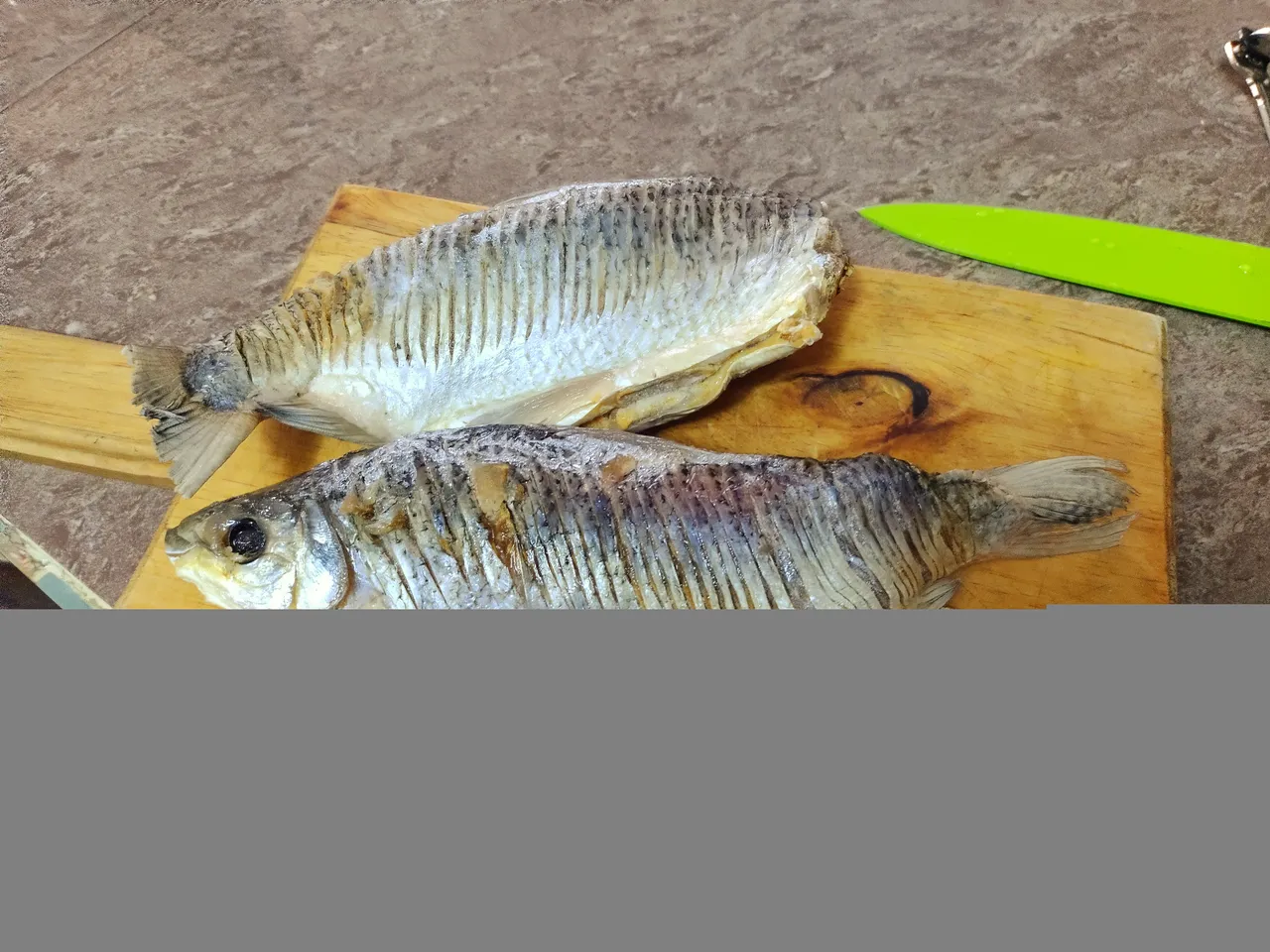
Los cortaremos en dos o tres partes, dependiendo del tamaño de la olla donde los coceremos. No te recomiendo que lo piques mas pequeños por las espinas, aunque si los fileteas, mucho mejor.
We will cut them into two or three parts, depending on the size of the pot where we will cook them. I do not recommend that you chop it smaller for the bones, although if you fillet them, much better.

Llevamos los pescados a una olla grande con unos dos litros de agua, dejándolos cocinar hasta que se torne tierna la carne (unos 20 minutos). Agregamos también una rama de cilantro, dos ajíes dulces, una cebolla y unos 5 dientes de ajo, ademas de comprobar la sal antes de la cocción.
We take the fish to a large pot with about two liters of water, letting them cook until the meat becomes tender (about 20 minutes). We also add a branch of coriander, two sweet peppers, an onion and about 5 cloves of garlic, in addition to checking the salt before cooking.
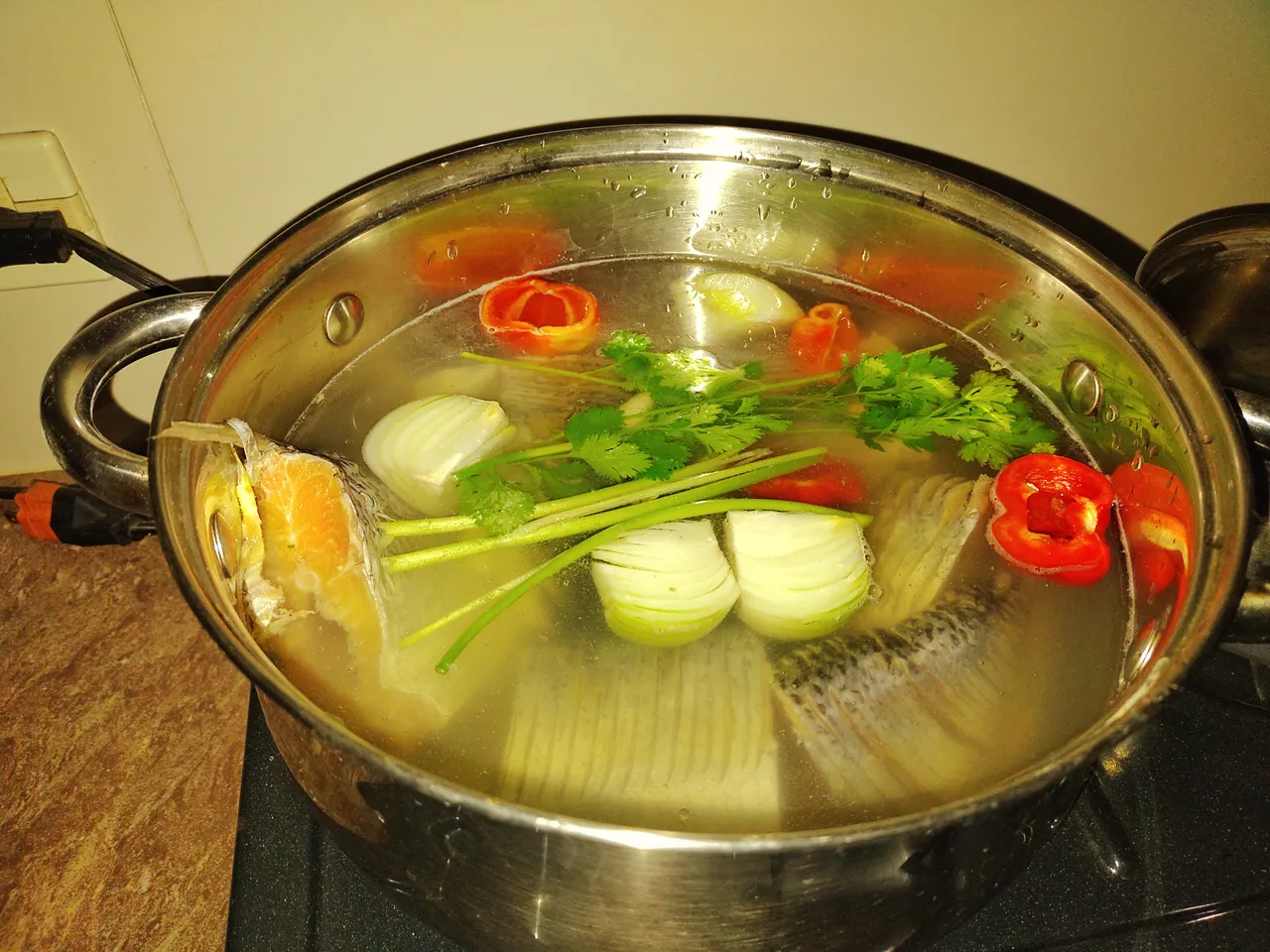
Cuando ya consigamos que el pescado se cocine, sacamos la olla del fuego y la dejamos enfriar por unos minutos.
When we get the fish to cook, we remove the pot from the heat and let it cool for a few minutes.
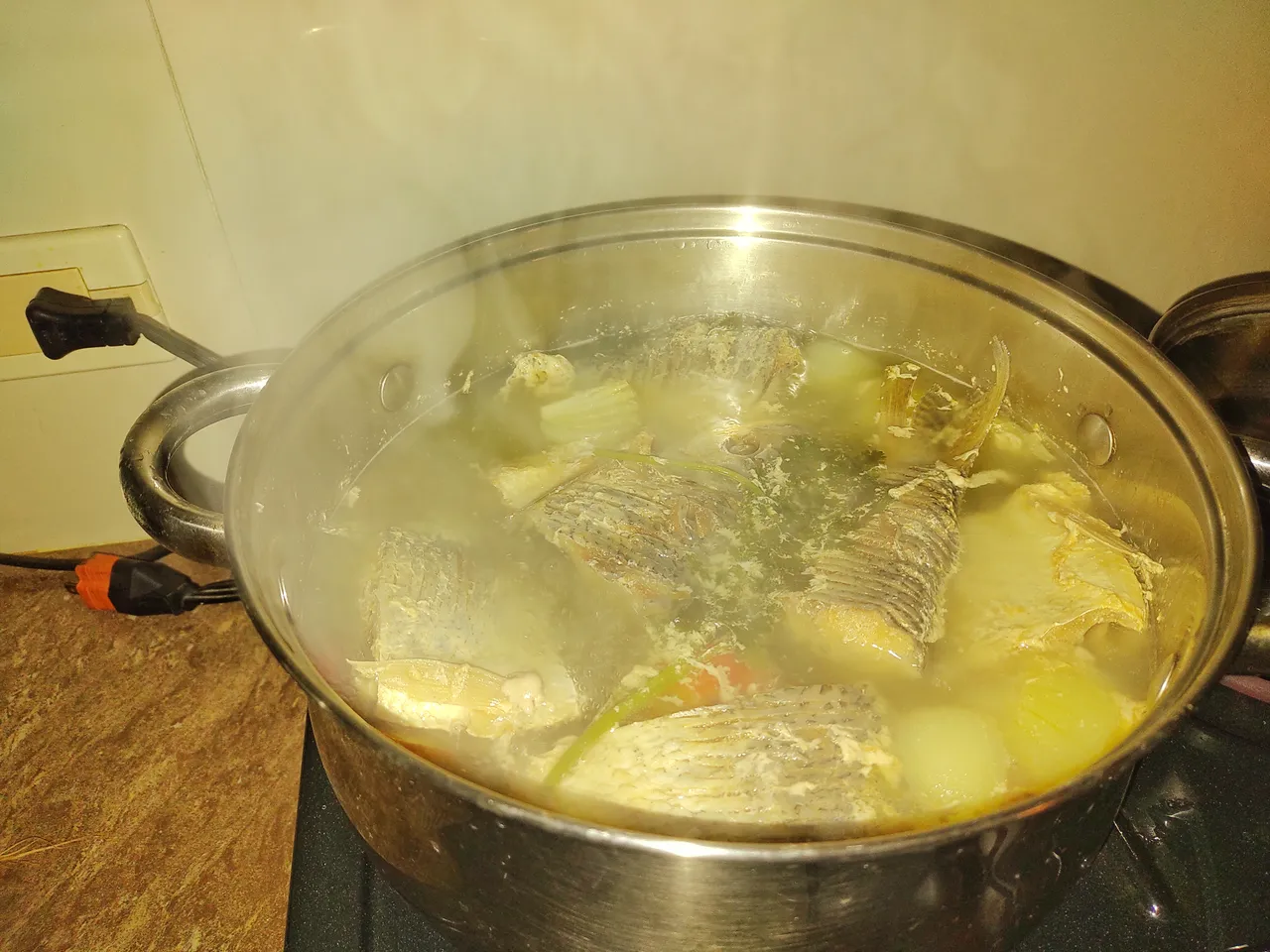
Una vez ya frio el caldo, podemos colarlo para sacar cualquier espina que este por allí. Este caldito lo podemos guardar en el congelador y utilizarlo para hacer otras recetas como una paella, por ejemplo.
Once the broth is cold, we can strain it to remove any spines that are there. We can keep this broth in the freezer and use it to make other recipes such as paella, for example.
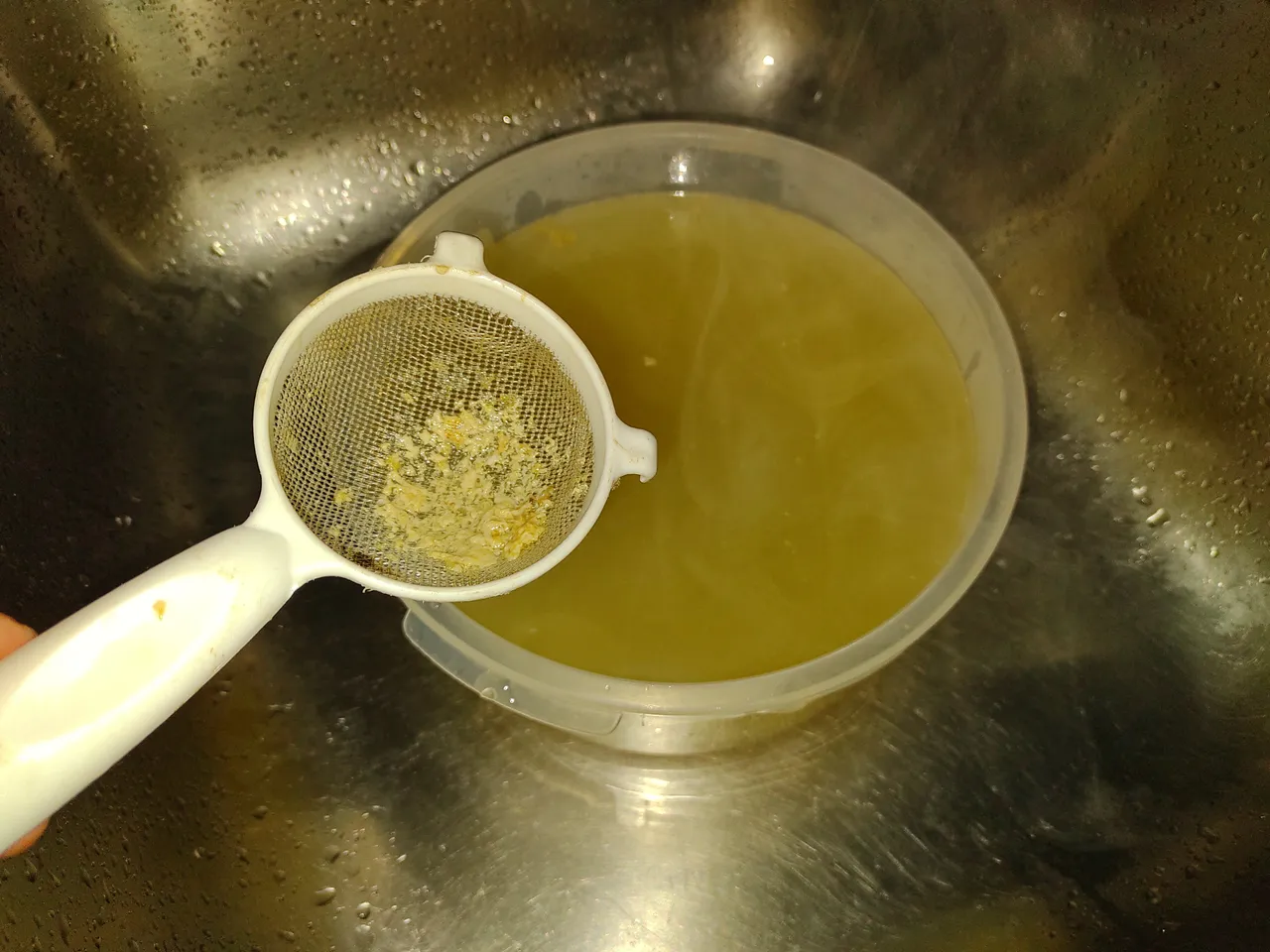
Ya con el pescado frio y sin el caldo, lo vamos a desmenuzar, sacándole bien las espinas. Como consejo personal, y para que se les haga mas fácil, les daré algunos de los trucos que yo utilizo para sacarle las espinas al pescado y morir en el intento.
With the cold fish and without the broth, we are going to crumble it, removing the bones well. As personal advice, and to make it easier for you, I will give you some of the tricks that I use to remove the bones from the fish and die trying.

Conservando la estructura del pescado, lo abro por la mitad, mostrándonos una mitad con la espina vertebral y la otra no.
Preserving the structure of the fish, I open it in half, showing us one half with the spine and the other not.
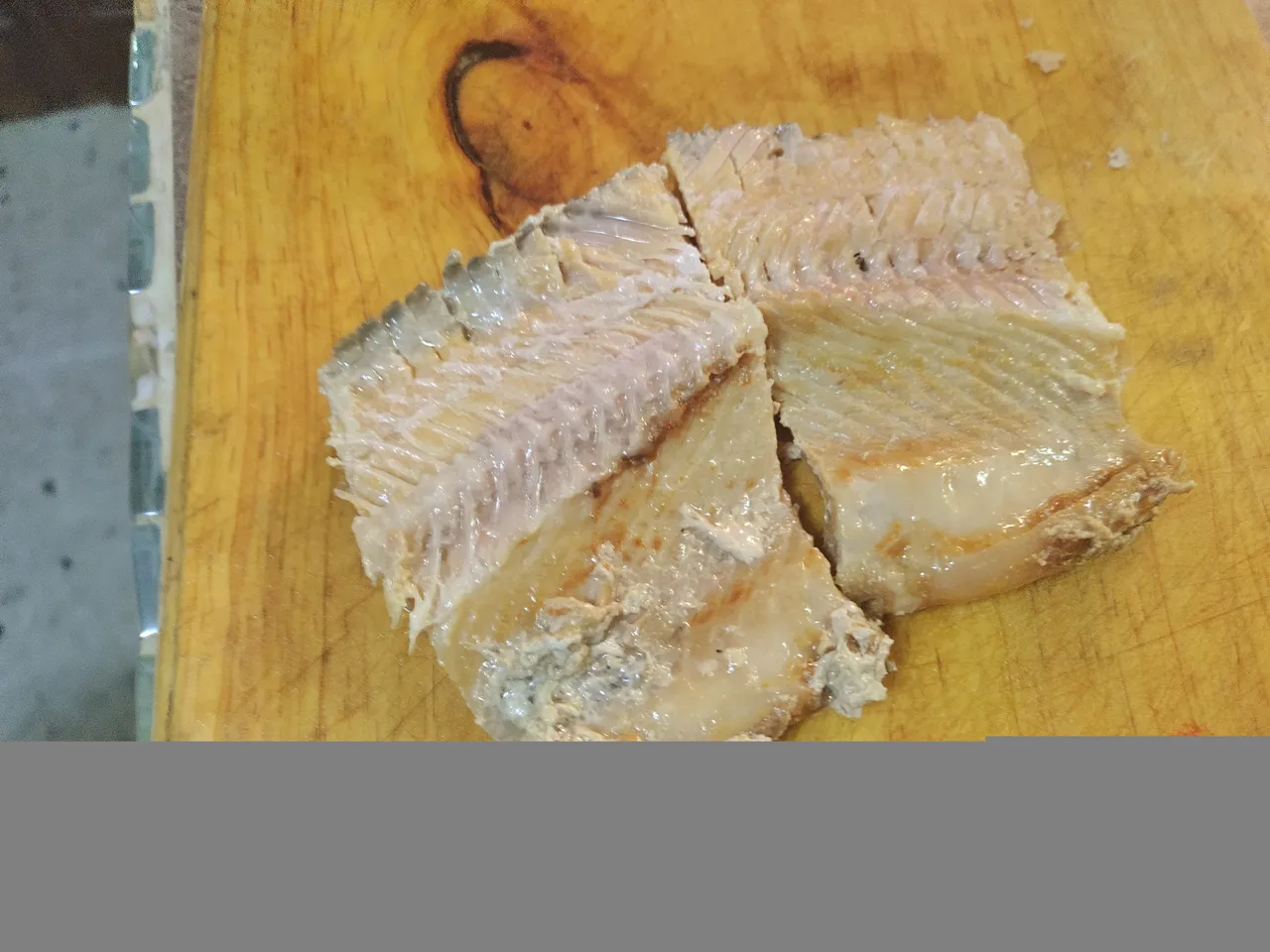
Con esto sacamos fácilmente uno de los cuatro grupos de espinas de los pescados.
With this we easily remove one of the four groups of fish bones.

Seguimos con la parte superior del pescado, aquí estarán las aletas, las cuales tendrán su grupo individual de espinas. Como ven en la foto es muy fácil retirarlas.
We continue with the upper part of the fish, here will be the fins, which will have their individual group of spines. As you can see in the photo, it is very easy to remove them.
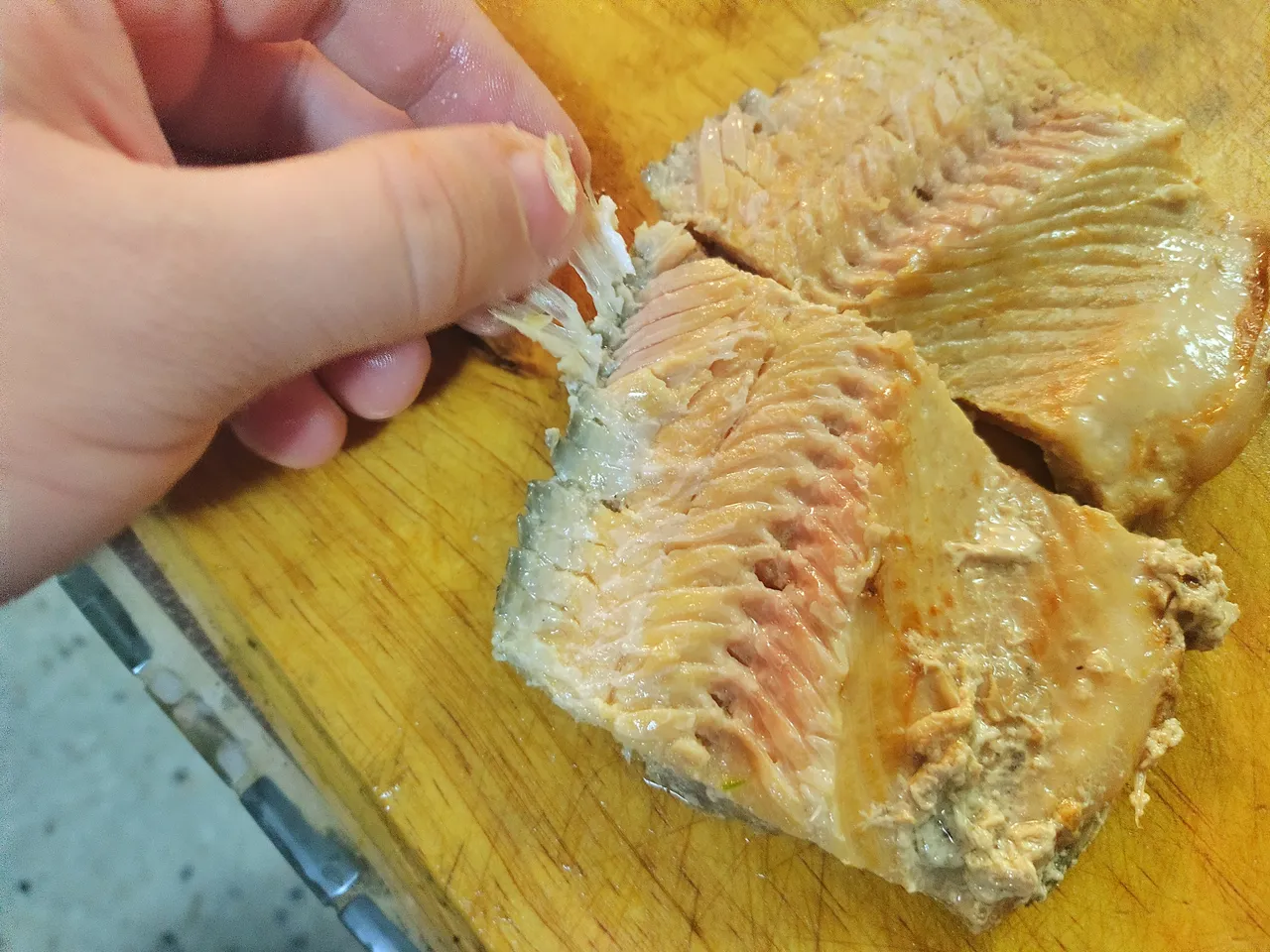
Luego en la parte inferior del pescado habrán otros dos grupos de espinas, unas que representan las aletas inferiores, que serian un par. El ultimo grupo de espinas están entre estas aletas y la espina vertebral del pez, donde estarían las costillas del animal, por asi decirlo.
Then in the lower part of the fish there will be two other groups of spines, some that represent the lower fins, which would be a pair. The last group of spines are between these fins and the spine of the fish, where the ribs of the animal would be, so to speak.
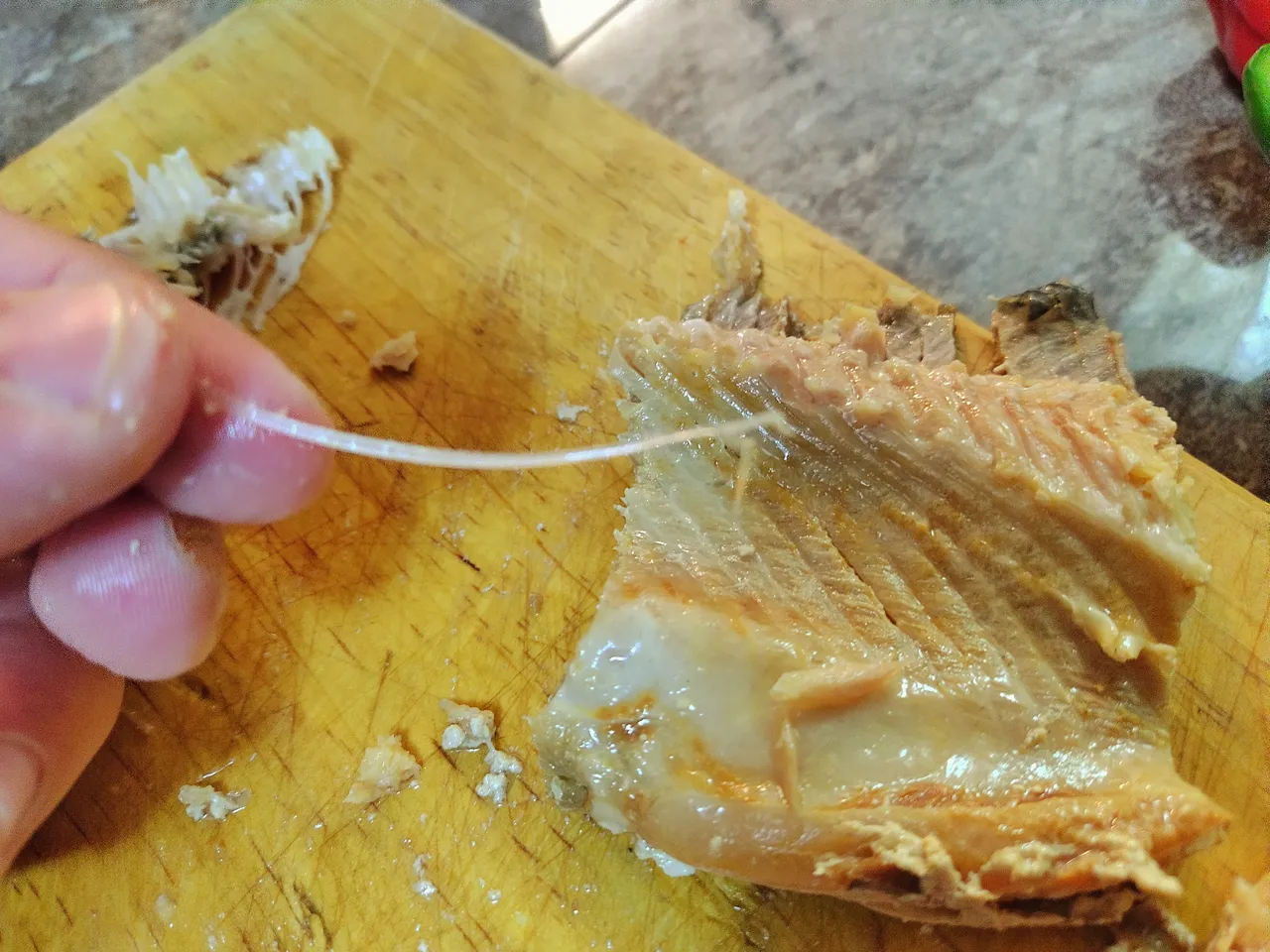
Estas son fáciles de retirarlas también, si te fijas hay como unos surcos oblicuos, bueno por allí pasan las espinas, haciendo que retirarlas sea sencillo. Como dije arriba, no recomiendo cortar mucho el pescado, ya que al intentar quitar las espinas en trozos pequeños, sera mas difícil ver la anatomía del pescado, haciendo que sea mas fácil que se nos escape alguna.
These are easy to remove too, if you notice there are some oblique grooves, well the thorns pass through there, making removing them simple. As I said above, I do not recommend cutting the fish too much, since when trying to remove the bones into small pieces, it will be more difficult to see the anatomy of the fish, making it easier for us to miss some.
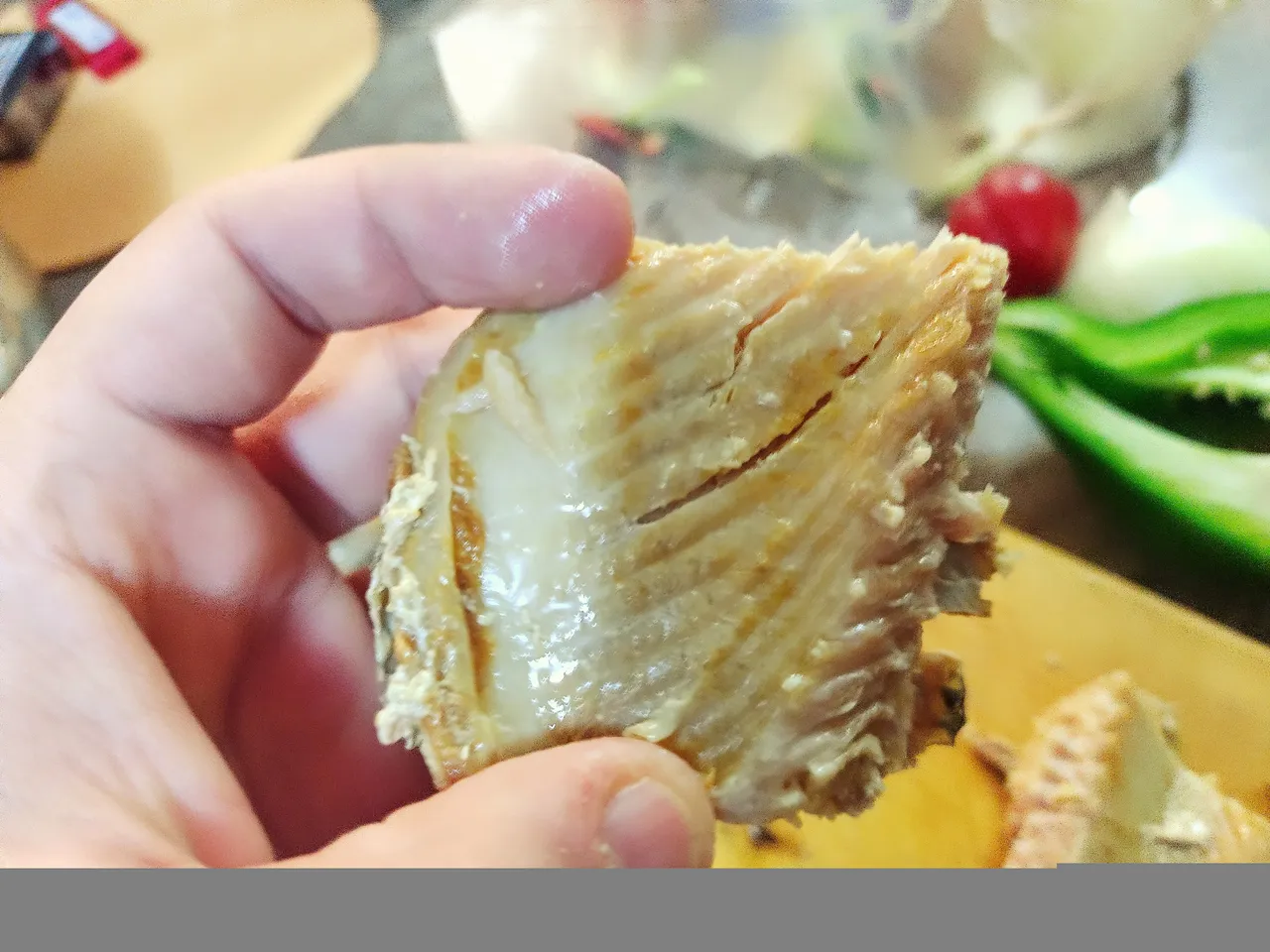
Por ultimo desmenuzamos el pescado y lo colocamos en un plato o vasija aparte, para evitar mezclar la carne con las espinas.
Finally we crumble the fish and place it in a separate dish or vessel, to avoid mixing the meat with the bones.
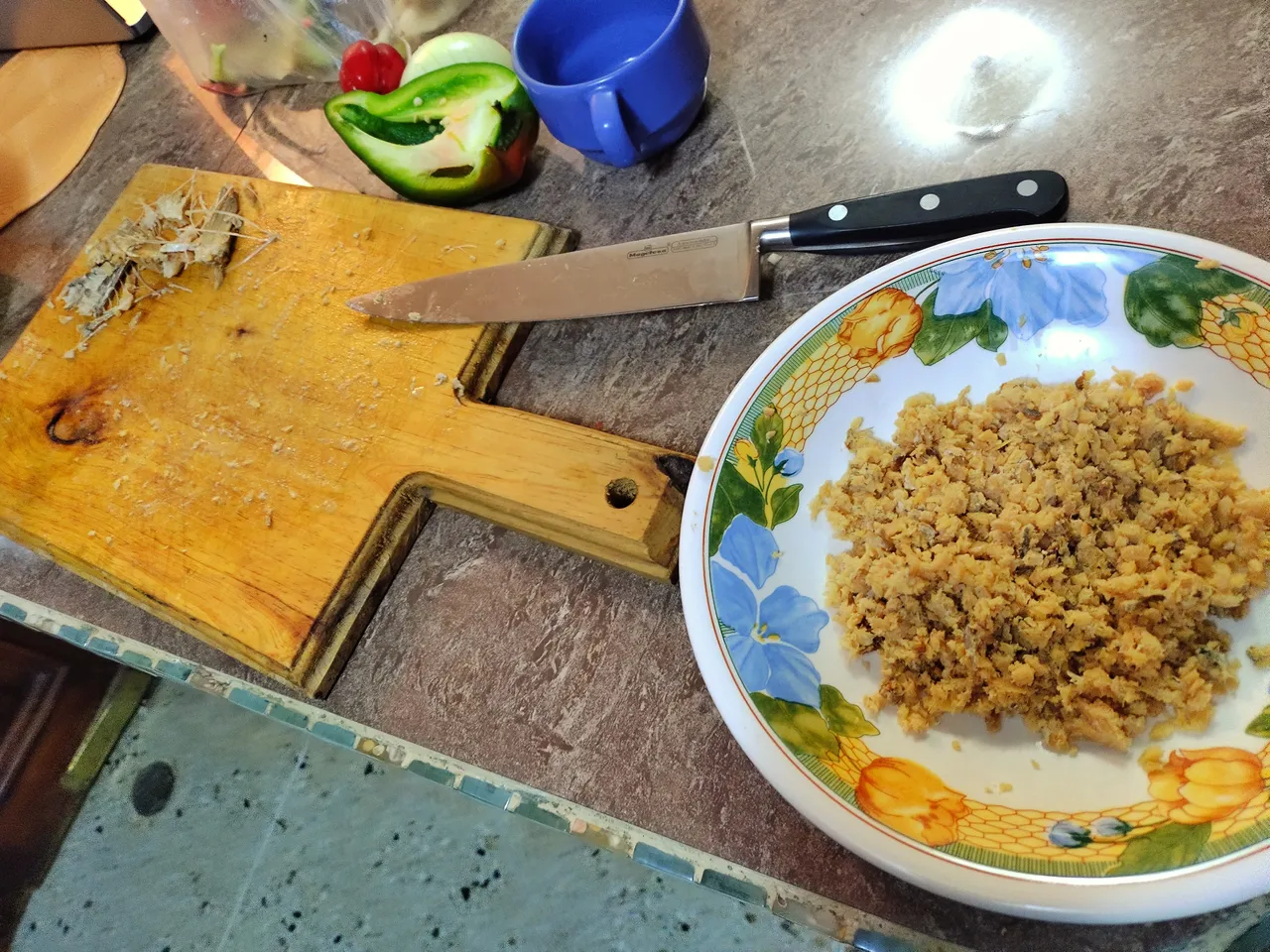
Este pescado lo reservamos por unos minutos mientras preparamos el sofrito. Recuerda taparlo ya que como toda comida marina, atrae muchas moscas.
We reserve this fish for a few minutes while we prepare the sauce. Remember to cover it since like all marine food, it attracts many flies.
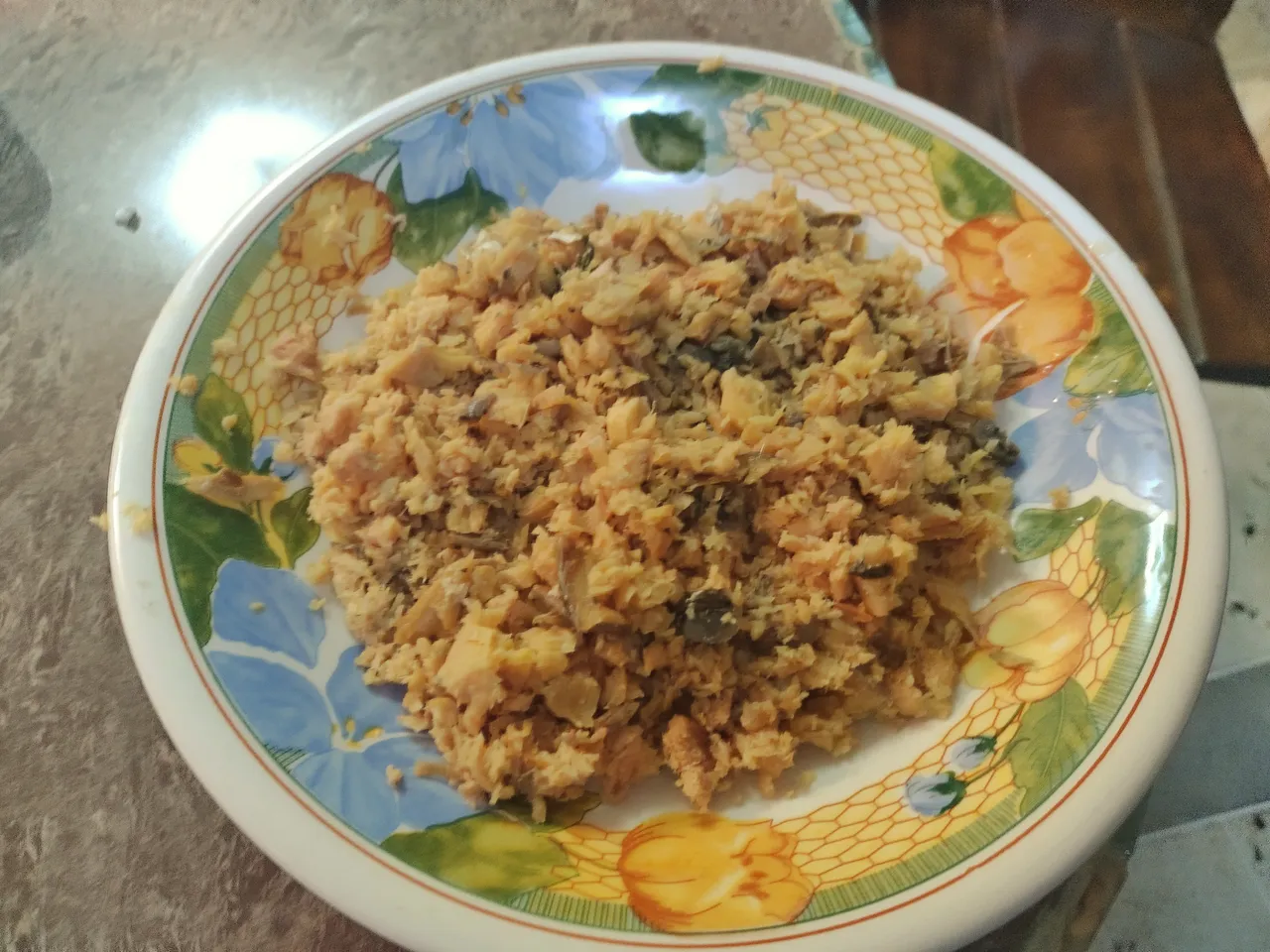
El resto de los vegetales que nos quedaron los cortamos en cuadritos pequeños y los llevamos a un sartén con una cucharada de mantequilla para sofreír.
The rest of the vegetables that we have left we cut into small squares and we took them to a pan with a tablespoon of butter to fry.

Ya pasados unos minutos, y cuando veas que la cebolla se torna traslucida, agregamos el pescado desmenuzado.
After a few minutes, and when you see that the onion turns translucent, add the shredded fish.
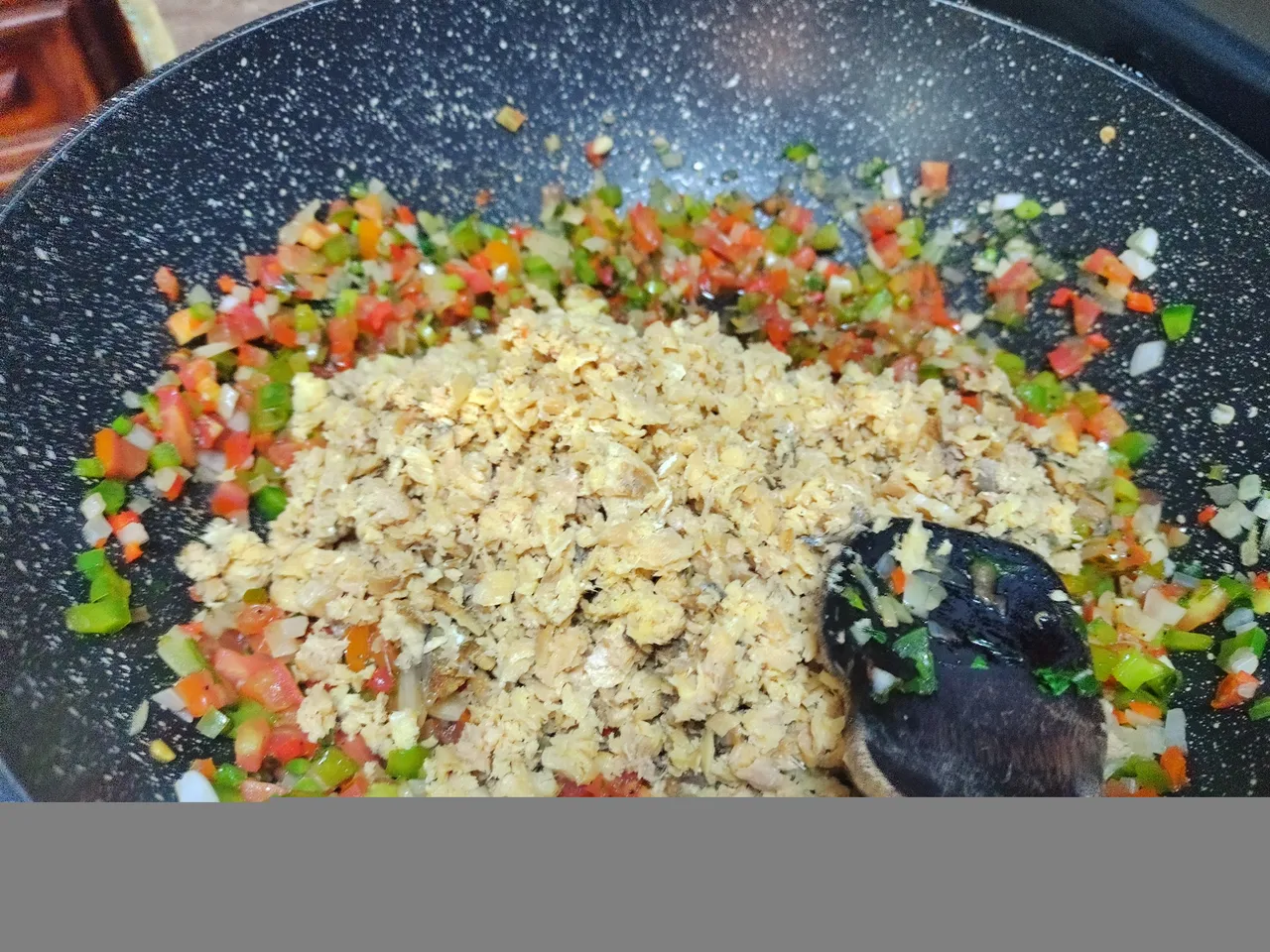
Aquí no agregaremos mas mantequilla sino que añadiremos un poquito de aceite onotado, que le agregara un poco de sabor, pero por sobre todo, mucho color, porque como están viendo, aun se ve el plato como pálido y algo aburrido, jajaja.
Here we will not add more butter, but rather we will add a little bit of oil, which will add a little flavor, but above all, a lot of color, because as you are seeing, the dish still looks pale and somewhat boring, jajaja.
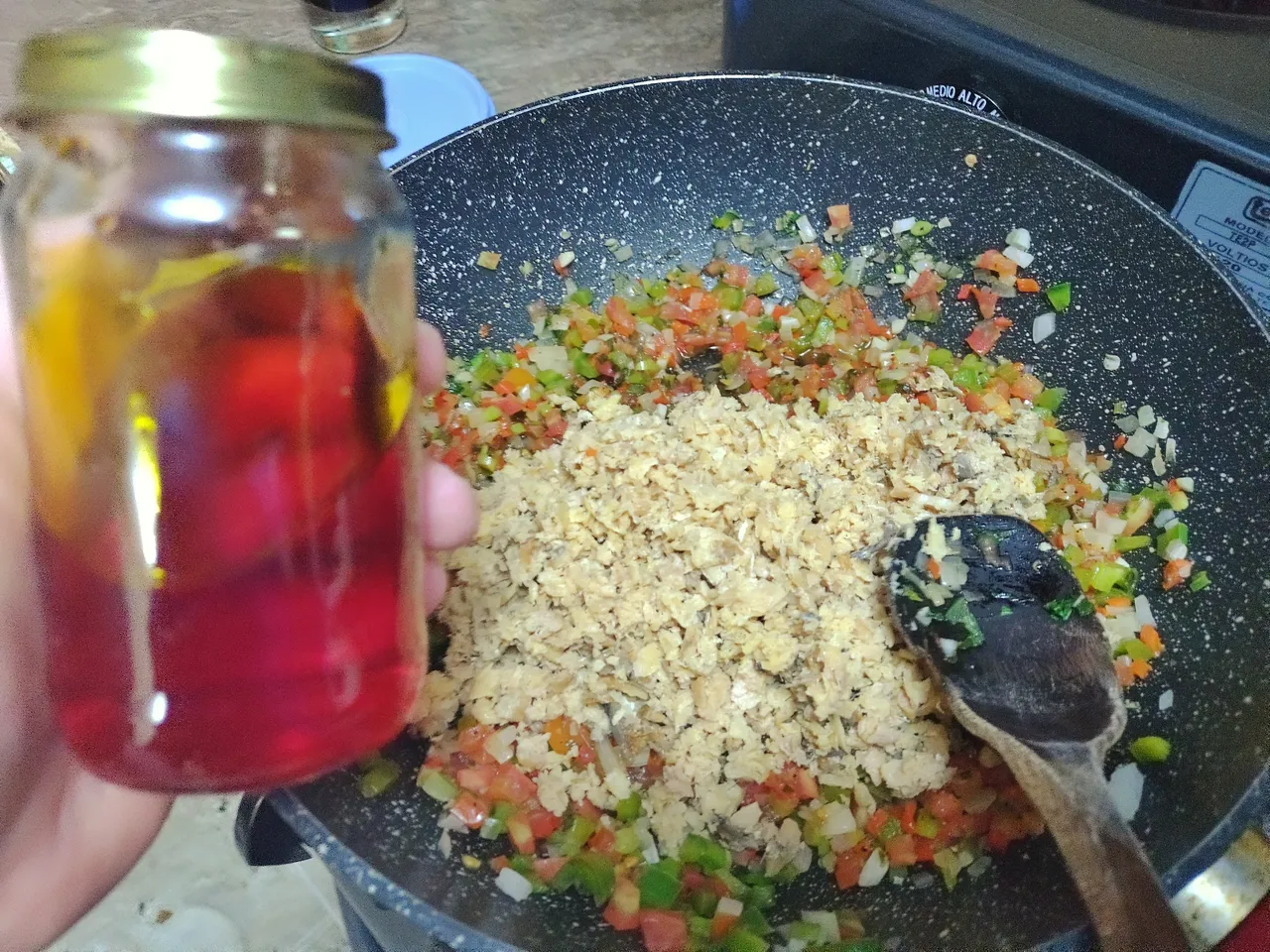
El pisillo estará listo cuando veamos que esta un poco seco (tampoco lo queremos como una piedra), pero lo que mas llama la atención es ese color amarillo, que lo hace lucir mas delicioso.
The pisillo will be ready when we see that it is a little dry (we do not want it as a stone either), but what is most striking is that yellow color, which makes it look more delicious.
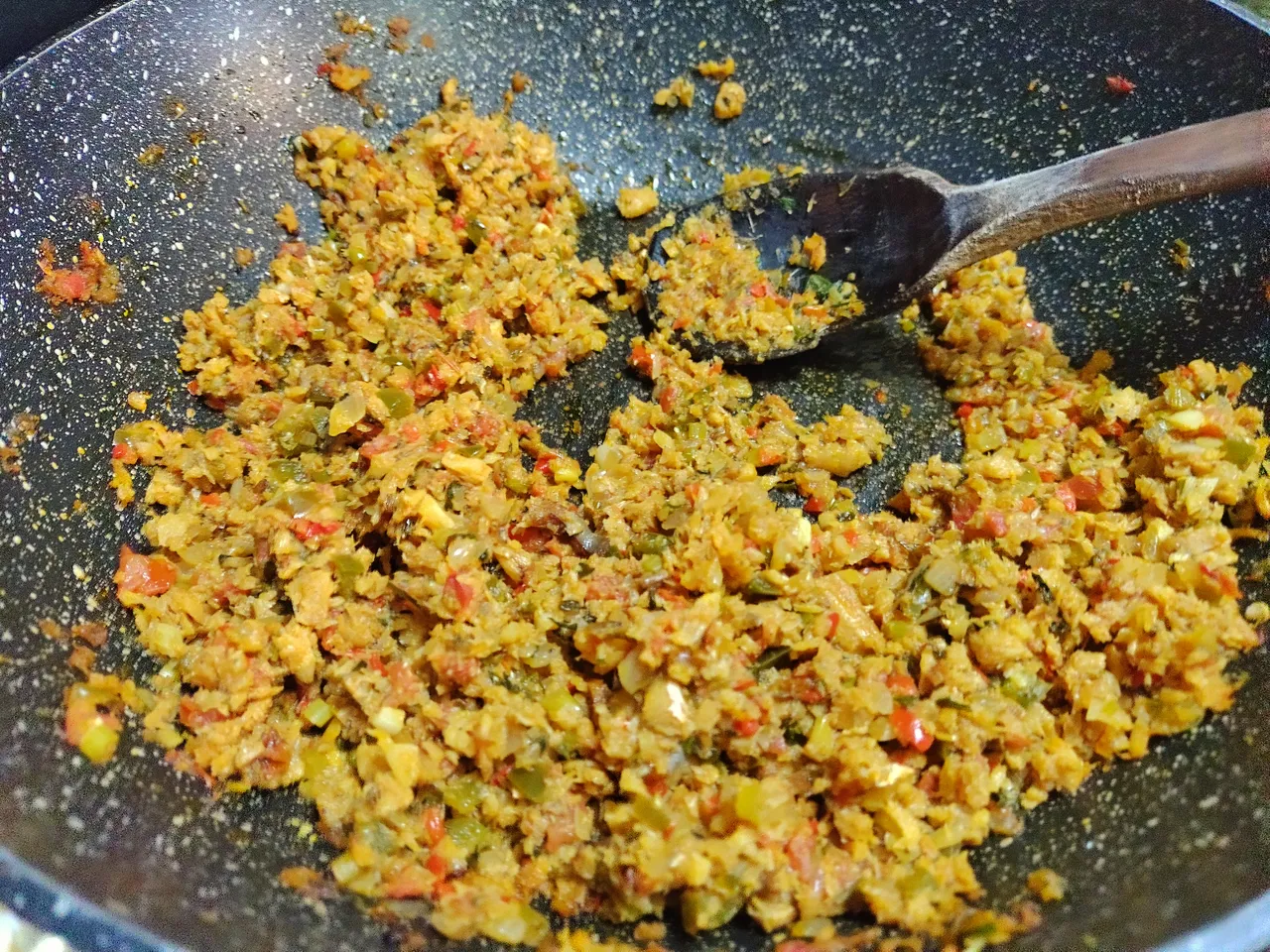
2- Por fin, ya es hora de armar las empanadas! / Finally, it is time to assemble the empanadas!
Comenzamos haciendo la masa de harina de maíz precocido. Las cantidades de esto es imposible saber, un venezolano solo agregara mas harina o mas agua de acuerdo a la necesidad de la masa, aunque un consejo es que tiene que quedar un poco aguada, ya que con el pasar de los minutos absorberá el exceso de humedad, y si esta muy seca, se agrietara la masa.
We start by making the precooked cornmeal dough. The amounts of this is impossible to know, a Venezuelan will only add more flour or more water according to the need of the dough, although a tip is that it has to be a little watery, since with the passage of minutes it will absorb the excess of moisture, and if it is too dry, the dough will crack.
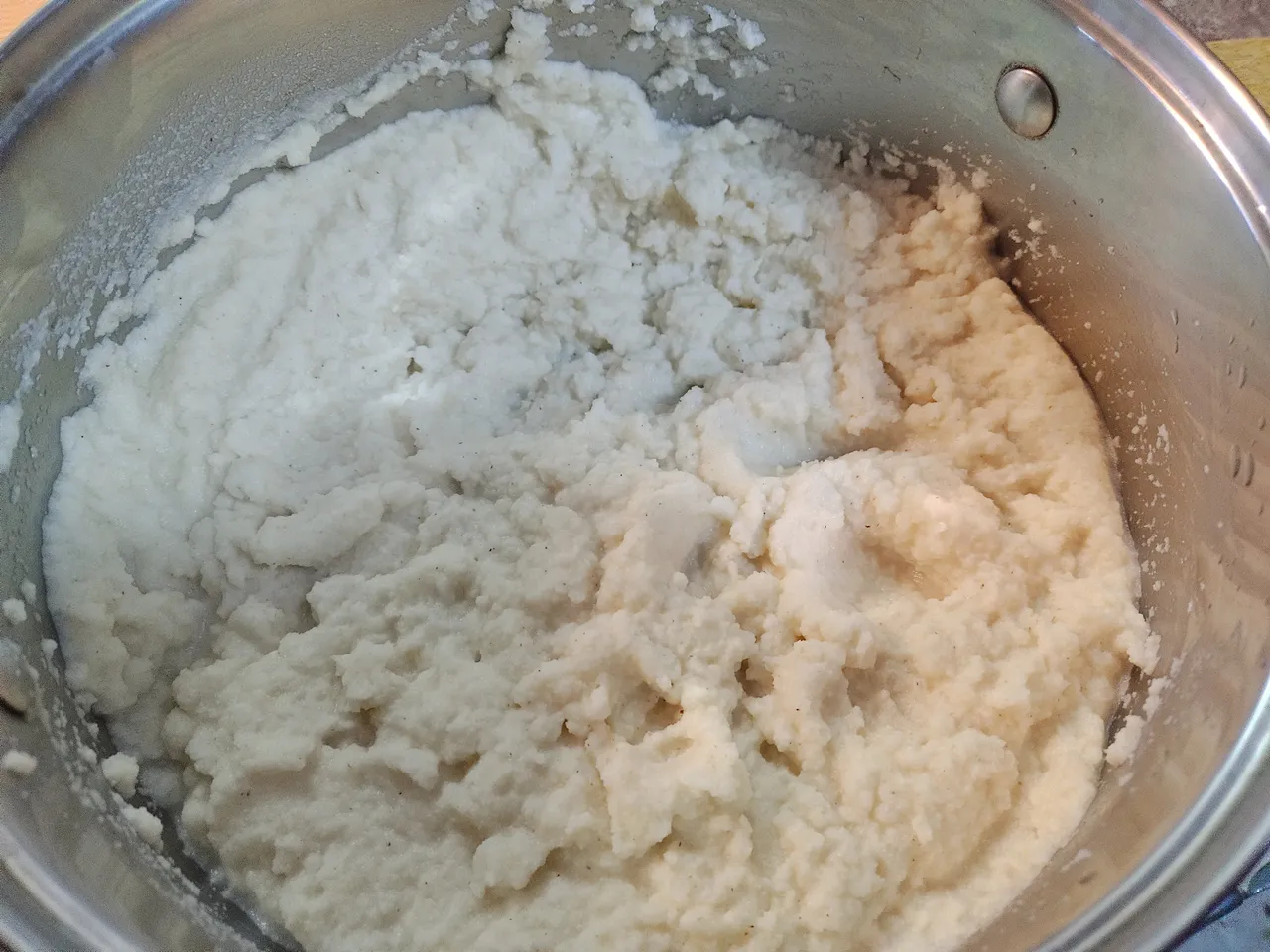
Para darle forma a la empanadas utilizaremos un plástico, que puede ser como en mi caso, una bolsa que lave muy bien con agua y jabón.
To shape the empanadas we will use a plastic, which can be, as in my case, a bag that washes very well with soap and water.
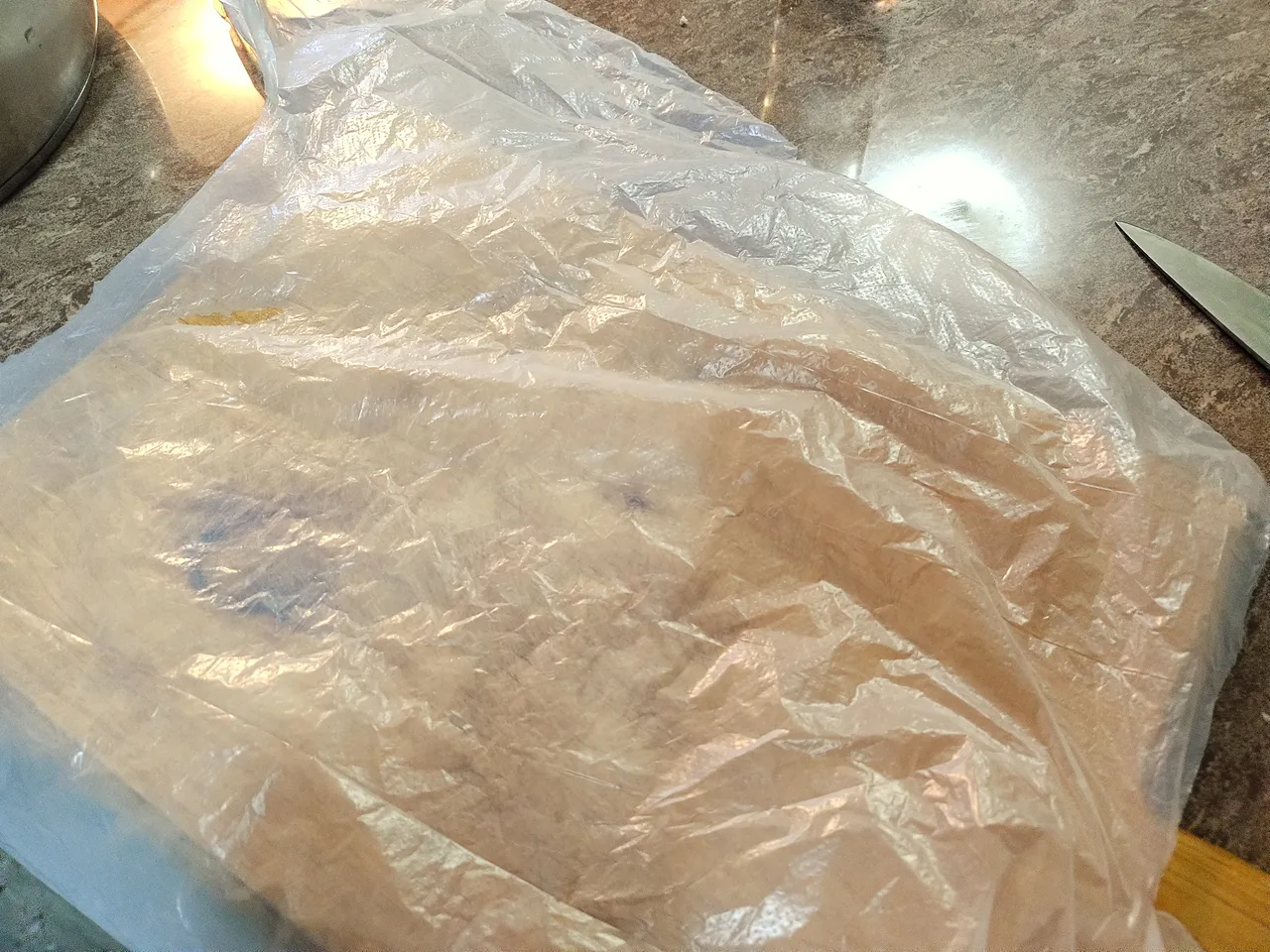
Tomamos un puñado de la masa y la esparcimos bien por el plástico, no es necesario que tenga una forma perfecta, ya que después retiraremos el sobrante.
We take a handful of the dough and spread it well on the plastic, it is not necessary that it has a perfect shape, since later we will remove the excess.
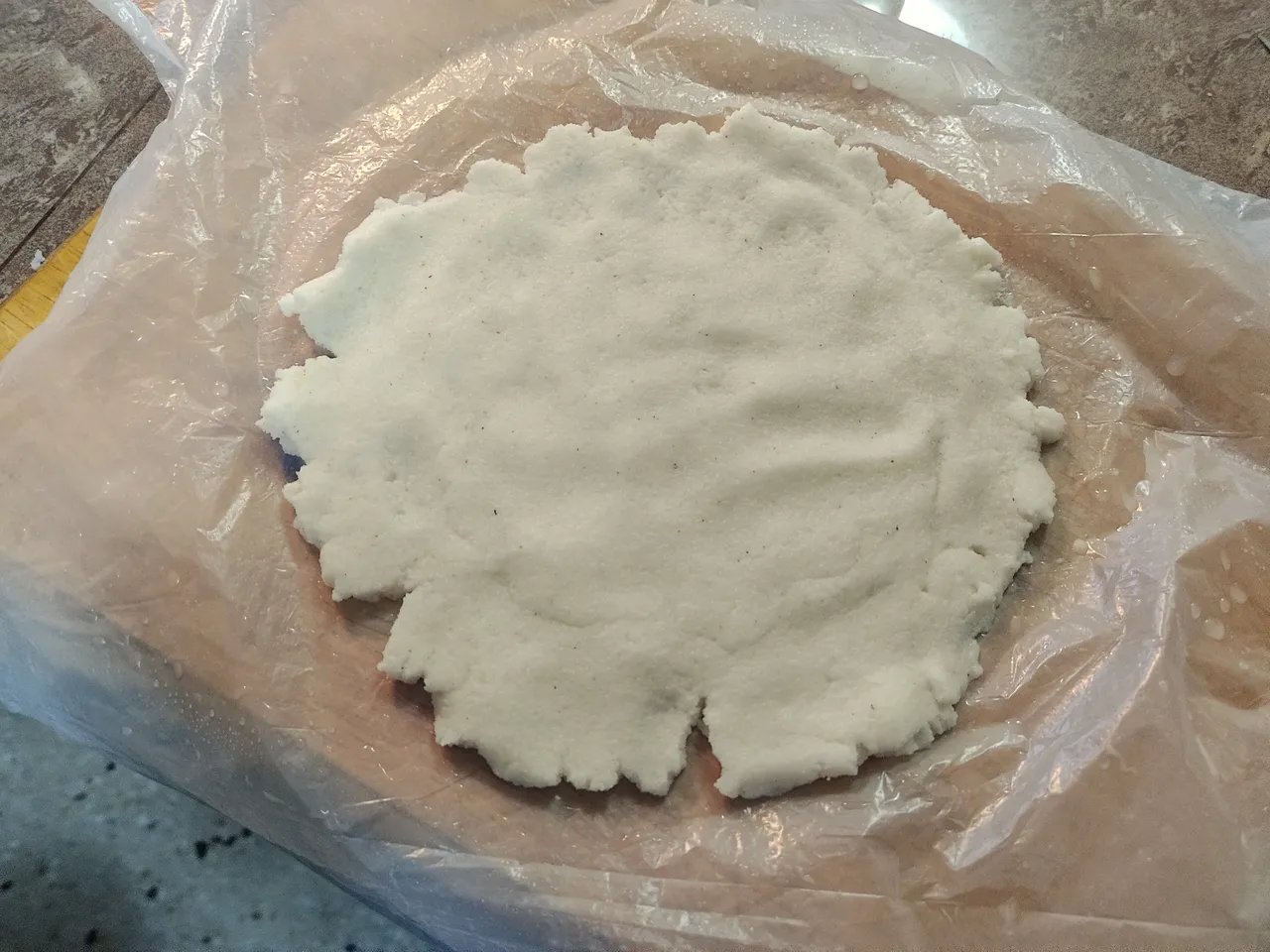
Colocamos una cucharada o cucharada y media de nuestro pisillo en la masa, recuerda que no debe ser demasiado para que no se reboce ni muy poco, nadie quiere una empanada de pura harina, jajaja.
We place a tablespoon or tablespoon and a half of our sauce in the dough, remember that it should not be too much so that it does not batter or too little, nobody wants a pure flour empanada, jajaja.
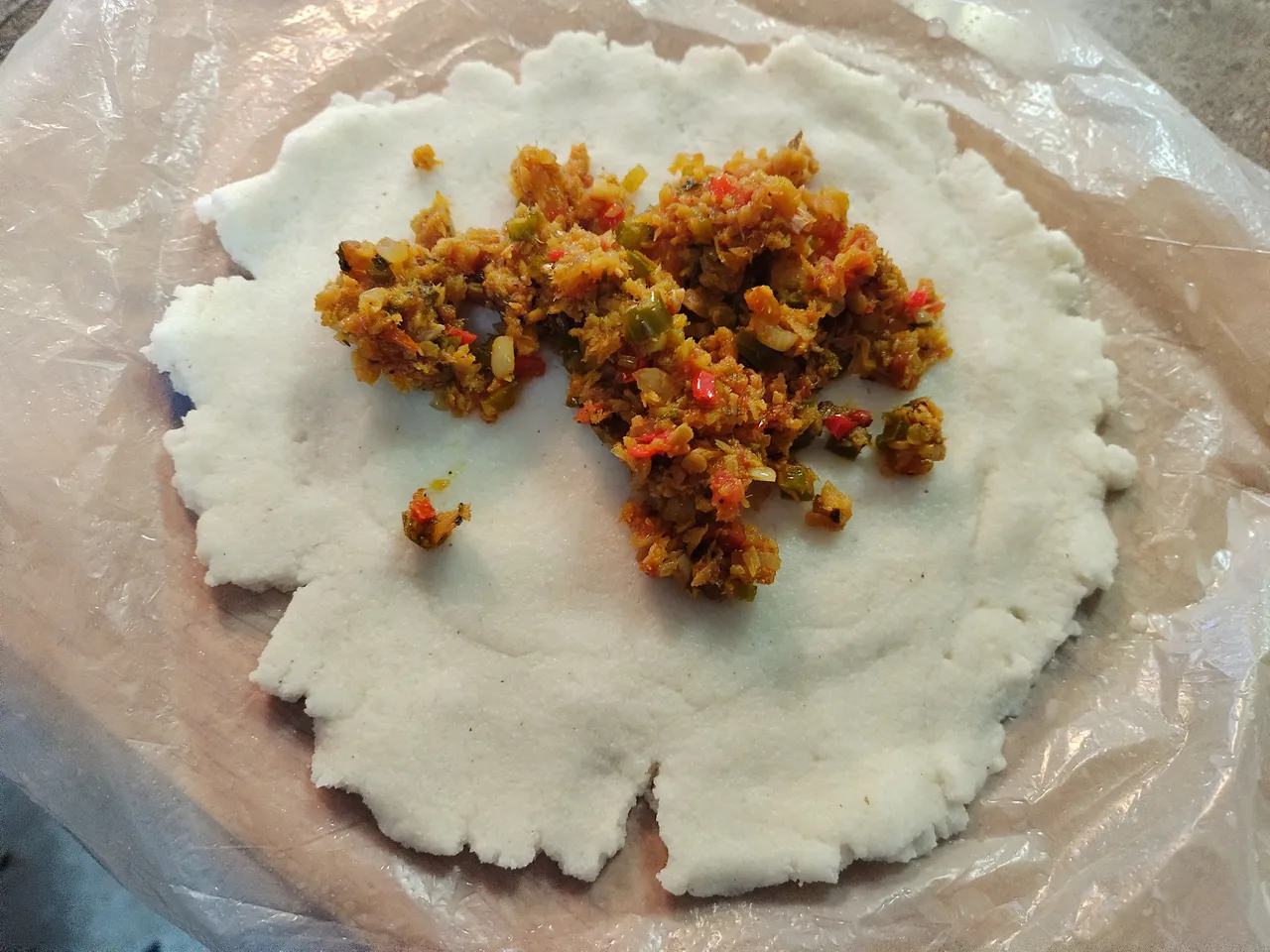
Doblamos el plástico, acercando los bordes de la harina uno al otro, y luego con ayuda de un plato o con nuestras manos, le damos la forma de media luna a la empanada y le quitamos la harina sobrante.
We fold the plastic, bringing the edges of the flour closer to each other, and then with the help of a plate or with our hands, we shape the pie into a half-moon and remove the excess flour.
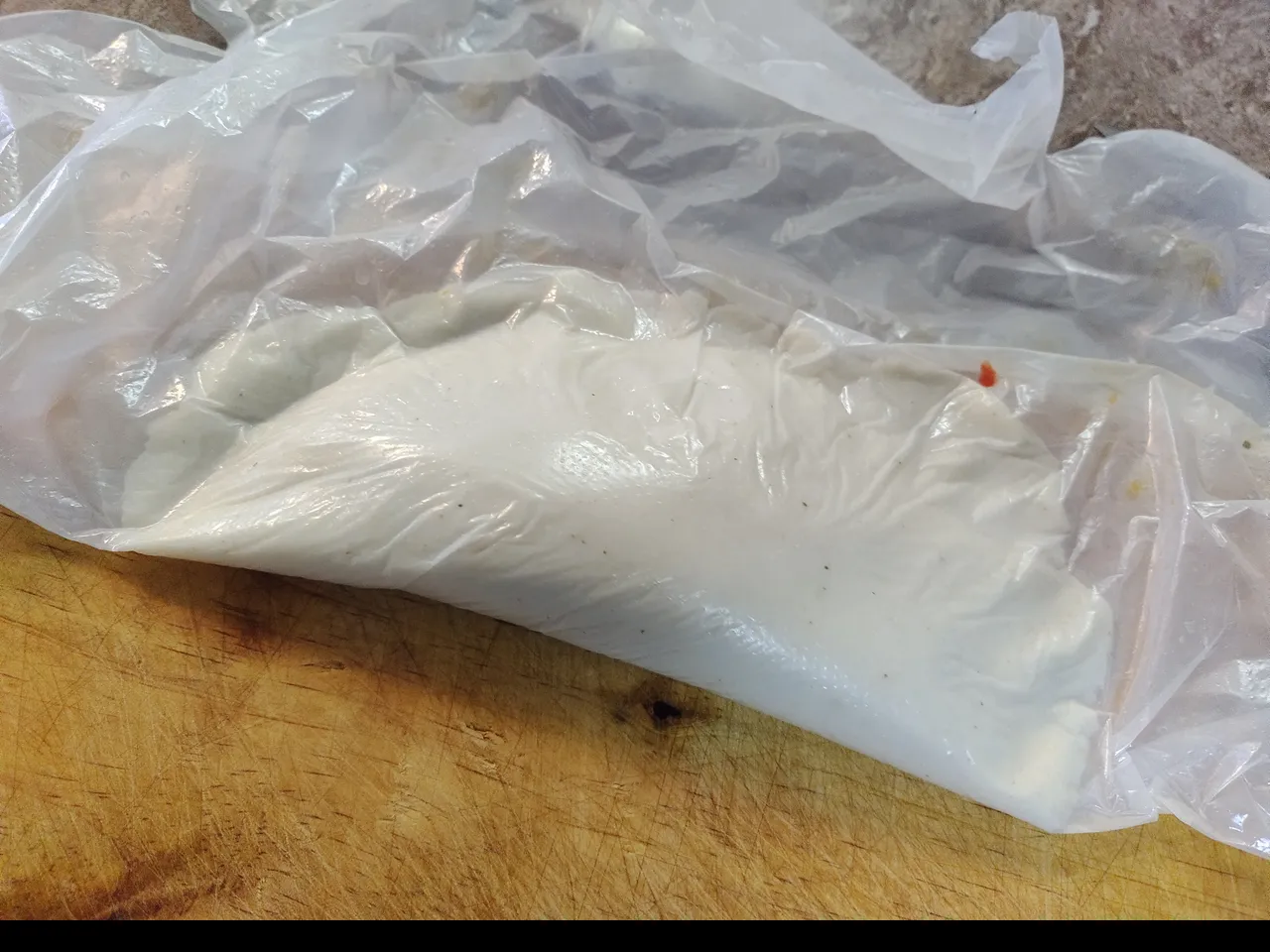
Debe quedarte algo parecido a esto, con el exceso de la harina. Cuando las lleves a freír, simplemente la volteas sobre tu mano y retiras el plástico para que la empanada caiga en tu mano (un consejo es que rocíes un poco de aceite en tu mano para que no se pegue la harina).
You should have something like this, with the excess flour. When you take them to fry, you simply turn it over on your hand and remove the plastic so that the empanada falls into your hand (a tip is that you sprinkle a little oil on your hand so that the flour does not stick).

Para comprobar que el aceite este lo suficientemente caliente, podemos agrega un pellizco de harina y si veces que flota y produce burbujas, estará listo para cocinar (como ven en la foto, a este aceite le hacia falta un poco).
To check that the oil is hot enough, we can add a pinch of flour and if it floats and produces bubbles, it will be ready to cook (as you can see in the photo, this oil needed a little).
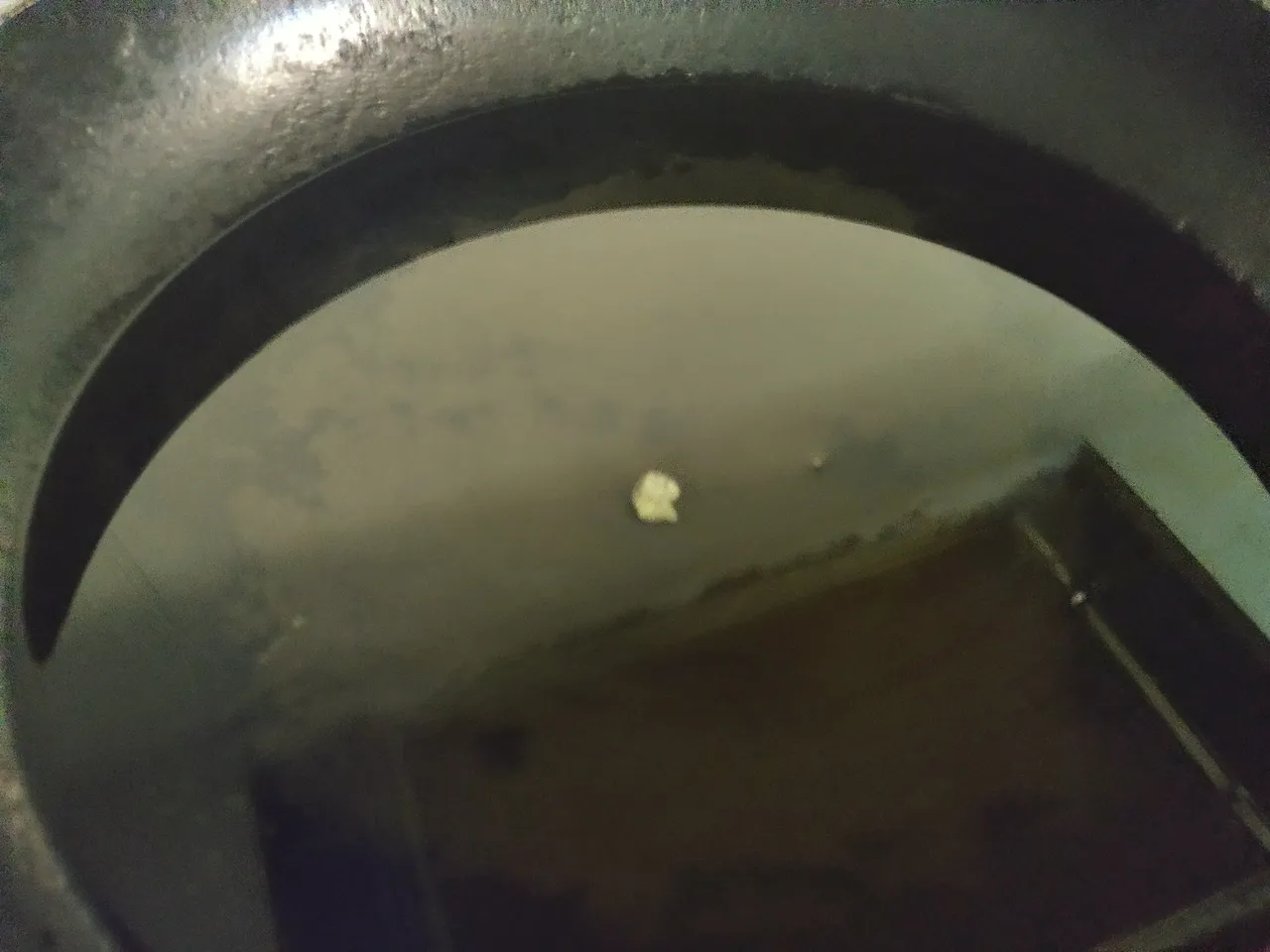
Ten mucho cuidado, ya que al colocar la empanada cruda o al voltearla el aceite se alborotara como veces en la foto (por cierto, pocos segundos antes me había quemado, jajaja). Cuando tomen un color doradito por ambos lados, estarán listas para sacarlas del aceite.
Be very careful, since when placing the raw empanada or turning it over, the oil will get upset like times in the photo (by the way, a few seconds before I had burned, jajaja). When they take a golden color on both sides, they are ready to be removed from the oil.

Dejalas enfriar un poco y estarán listas para disfrutar. Tal cual como lo haría en la playa, no hay nada mejor que acompañar estas empanadas con una malta bien fría una salsita de ajo, es lo mas cercano a la gloria, jajaja.
Let them cool a bit and they will be ready to enjoy. Just as you would on the beach, there is nothing better than accompanying these empanadas with a very cold malt and a garlic sauce, it is the closest thing to glory, jajaja.

Esta fue mi entrada para el concurso, espero que les haya gustado tanto como a mi al comerlas, jajaja. Las empanadas son una comida especial para compartir con tus seres queridos, así que si tienes la oportunidad, cocina unas para la cena y consciente a tu familia, o incluso, si no estas en Venezuela, cocinalas para tus amigos, es una bonita forma de compartir y conocer otras culturas, y pues a mi me funciono, después tendrán una excusa para probar las múltiples recetas de otras culturas, jajaja.
This was my entry for the contest, I hope you liked it as much as I did when eating it, jajaja. Empanadas are a special meal to share with your loved ones, so if you have the opportunity, cook some for dinner and make your family aware, or even, if you are not in Venezuela, cook them for your friends, it is a nice way to share and get to know other cultures, and well it worked for me, then you will have an excuse to try the many recipes from other cultures, jajaja.
